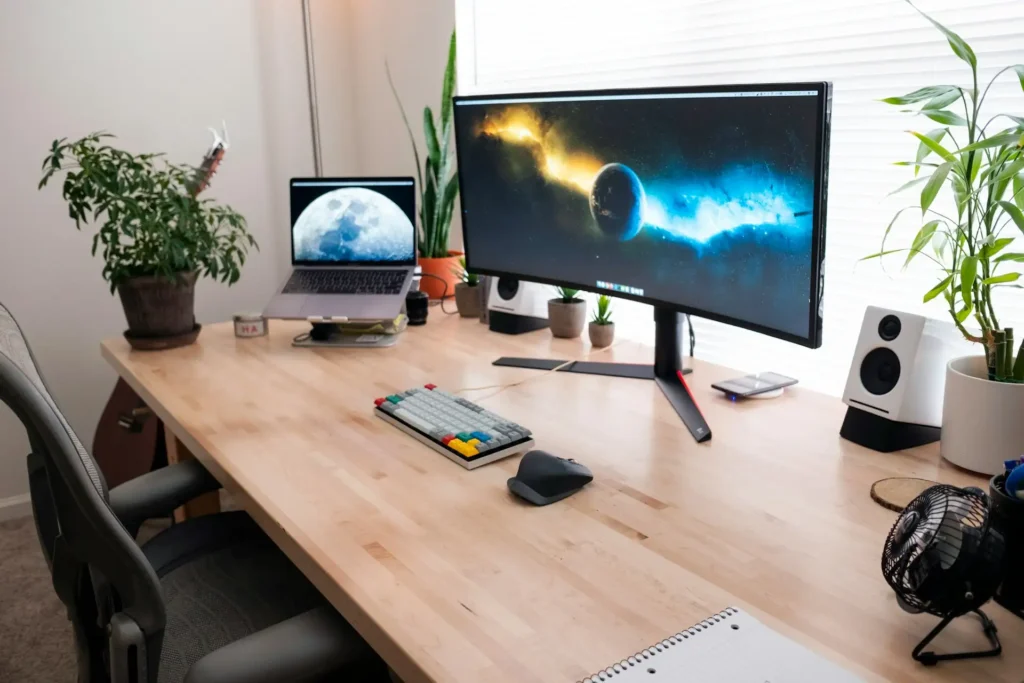Do you notice when your setup is working against you? At first, it’s just a little neck stiffness.
Some days, your eyes feel heavy by the afternoon. Or you keep getting distracted, losing focus, reopening the same tab five times. It doesn’t feel like a big deal. Until it keeps happening over and over. Now, you start getting a bit more conscious of it. You struggle to keep your usual workflow going.
But what if the problem isn’t your routine or your willpower? What if it’s the shape of your screen?
A curved monitor isn’t just a cool-looking upgrade. It subtly reshapes how you experience your daily work or play. And for a lot of people, gamers, creators, and developers, it turns out to be the small change that quietly improves everything.
Let’s unpack why.
The Curve That Works With You (Not Against You)
Our eyes aren’t made for flat rectangles. When you sit close to a large monitor, your peripheral vision has to stretch to keep up. That means your eyes are constantly adjusting, especially toward the edges. The result? Fatigue misses details, and a surprising amount of low-level discomfort you don’t even notice until later.
A curved monitor works differently. The screen gently arcs around your natural field of view. That means every corner stays roughly the same distance from your eyes. No more leaning in to read the edges or squinting to catch details in the corners.
Instead, you stay centered. Literally and mentally. The curve draws you in, reduces visual distortion, and lets you focus longer without that creeping drain on your energy.
What It Feels Like for Gamers
For gamers, the benefit is instant. A curved display creates a sense of depth that makes flat screens feel, well, flat. Especially with larger sizes or ultrawide formats, the screen pulls your field of view into the experience. Peripheral enemies? Easier to track. Driving through a game world? More immersive. You’re not just watching the game, you’re inside it.
It’s not just about looks, either. The curved design keeps motion smooth and reduces eye movement. That means less strain in long sessions and better tracking in fast-paced games. For anyone who plays competitively or just obsessively, it’s one of those upgrades you feel more than you see.
How Creators and Editors Use the Curve
Video editors, photo retouchers, and designers, anyone who builds visuals for a living, know how demanding it is to stare at a screen for hours, adjusting tiny details. Flat monitors often cause color shifts at the edges or make you constantly shift your posture just to view an entire timeline or layout properly.
A curved monitor keeps everything centered. Timelines stretch naturally across your view, with less need to pan or zoom. Colors stay more consistent edge-to-edge. You can review your work as a whole, not in sections. It sounds small, but over a full workday, that comfort compounds.
For creators juggling layers, tools, and reference materials all at once, curved ultrawide displays aren’t a luxury. They’re a workspace that fits your work instead of making you fit into it.
Why Developers and Multitaskers Love It
Here’s something developers figure out quickly: more screen space means less mental friction. But dual monitors can be messy bezel gaps, inconsistent scaling, and awkward layouts. A single curved ultrawide smooths all of that out.
You can run your editor, terminal, docs, and browser side by side. No alt-tabbing, no second-guessing which screen your cursor’s on. Everything flows in one continuous line of sight. It feels more like a cockpit than a desk.
Even for non-tech users, analysts, project managers, and students, a curved monitor simplifies multitasking. Less bouncing between tabs. More time actually getting things done.
What to Look for in a Curved Monitor
So, before buying any of them, you must know what makes one curved monitor better than another. The curve itself is only part of the story. Here’s what matters when choosing one that fits your needs:
Size & Aspect Ratio
Curved displays shine when they’re big enough to wrap into your vision. Smaller ones often miss the point. Look for at least 32 inches or ultrawide formats like 21:9 or 32:9 if you really want the curve to work its magic.
Curve Radius
This is where numbers like 1000R or 1800R come in. A lower number means a tighter curve.
- 1000R feels more immersive, ideal if you sit close or want that deep wrap-around feel.
- 1800R is gentler, better if you prefer a wider viewing distance or switch between tasks frequently.
Panel Type
Before making up your mind to purchase one, make sure you understand the panel type because they’re not all equal
- OLED and QD-OLED offer incredible contrast, deep blacks, and vivid color—great for gaming or creative work.
- VA panels tend to have stronger black levels but sometimes struggle with color accuracy.
- IPS panels (less common in curved) offer good colors and wide viewing angles.
Refresh Rate & Features
If you’re a professional gamer or a game lover, you’ll want higher refresh rates (120Hz and up), adaptive sync (like FreeSync or G-Sync), and low response times for the fastest and smoothest gameplay.
For creators and office use, you need a versatile monitor for work, creation, and media, so you have to focus on balanced performance with color accuracy and connection ports (USB-C, DisplayPort, etc.), which matter more than you think.
The Curve Isn’t for Everyone, But It Might Be for You
Curved monitors aren’t a blanket solution. They’re a fit for a specific type of user who can actually use the benefits. If you are comfortable working with mostly a laptop, or you’re doing highly precise architectural or CAD work where straight lines must stay straight, a flat display might still make more sense than a curved one.
But for everyone else who spends hours in coding, gaming, and timelines, or 30-tab browser windows, the right curved monitor can undoubtedly increase their workflow. It feels like someone finally built a screen for the way our brain wants to work.
Final Thought
If you’re serious about your time and productivity, whether it’s for work, gaming, or content creation. Then switching to a curved monitor isn’t just a nice-to-have upgrade. It’s a change that subtly shifts how you engage with your tasks, making you focus longer.
When your eyes move more naturally, you can easily feel more connected to what’s in front of you. Which boosts your productivity. So what are you thinking? It’s time to make up your mind. Sometimes, the best way to see things is to give them a little curve.










